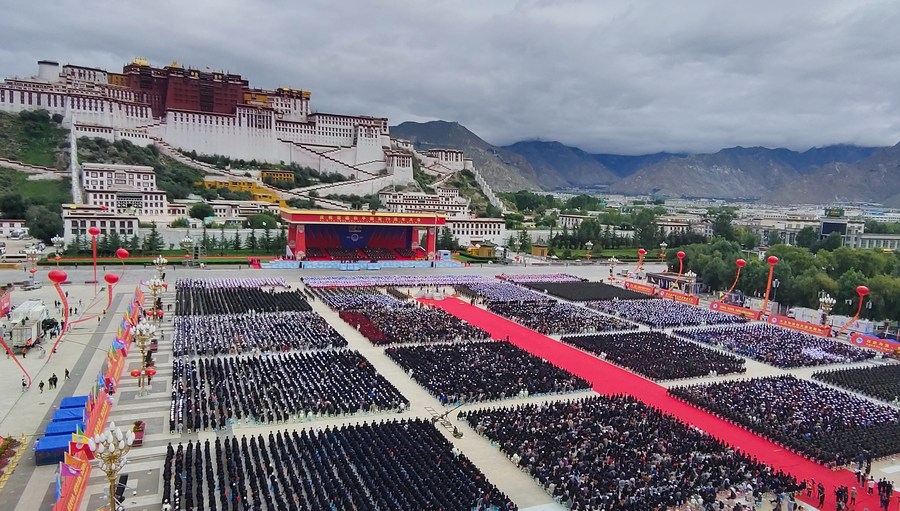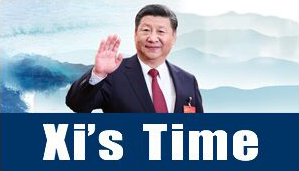
A grand gathering is held to celebrate the 70th anniversary of the peaceful liberation of Tibet at the Potala Palace square in Lhasa, southwest China's Tibet Autonomous Region, Aug. 19, 2021. (Xinhua/Sun Ruibo)
LHASA, May 23 (Xinhua) -- Barkhor Street is a famous scenic and shopping area in Lhasa, capital of southwest China's Tibet Autonomous Region. Near the street sits a mosque, which stands out against the background of neighboring Tibetan-style buildings.
While Buddhists worship at the landmark Jokhang Temple on the street, local Muslims go to the mosque regularly to pray.
The community of Wabaling, where the mosque is located, is home to over 8,700 people from 10 ethnic groups, including Han, Tibetan, Hui and Bai. Despite having different religious beliefs and customs, residents live there in harmony, with many families made up of two or more ethnic groups.
Chinese President Xi Jinping has stressed on many occasions that the Chinese nation is closely united like the seeds of a pomegranate. "We are all members of the community of the Chinese nation."
CARING NEIGHBORS
Liu Gabu, a Hui ethnic, goes to the mosque every Friday. Liu, from northwest China's Gansu Province, came to Lhasa 32 years ago to start a beef and mutton business.
"I fell in love with the city largely because the people here are so nice," said Liu, 51.
He recalled his two-wheeled cart, which he used to deliver meat, often getting stuck back when the roads in Lhasa were still bumpy. "I often found Tibetan strangers coming to help pull out the cart," he said.
Via a matchmaker, Liu met his wife, a Tibetan from Sichuan Province. Now, the couple has bought a villa with six bedrooms in Lhasa. When the family leaves for vacation, they will leave the door key to a Tibetan neighbor.
"My neighbor is very kind. He will take care of our house, and help us water the flowers," said Liu.
In Tibet, there are 45 ethnic groups with Tibetans and other ethnic minorities accounting for about 90 percent of the population.
The region has long had a fine tradition of exchanges, communication, and integration among ethnic groups since ancient times. In the seventh century, Tibetan King Songtsen Gampo married Princess Wencheng of the Tang Dynasty (618-907), starting a new chapter of building ties among different ethnic groups.
Since the reform and opening up in 1978, economic and cultural exchanges between ethnic groups have become closer and their sense of national identity has grown stronger.
While addressing the central conference on ethnic affairs last August, Xi, also general secretary of the Communist Party of China (CPC) Central Committee and chairman of the Central Military Commission, said guiding all ethnic groups to jointly strive for fully building a modern socialist country must be taken as a crucial task of the ethnic work of the CPC in the new era.
ONE COMMUNITY, ONE FAMILY
Yangpel, a community worker from Wabaling, said more than 100 couples spanning Tibetan, Hui and Han ethnic groups have wedded in the Wabaling community. During festivals of different ethnic groups, the community will organize activities, inviting the families of cross-ethnic groups to enjoy festive food.
"We offered mooncakes at the Mid-Autumn Festival and yogurt at the Tibetan Shoton Festival for them to enjoy together," she said.
Halima, 81, enjoyed the mooncakes distributed by the community last year. The former Tibetan farmer named herself "Halima," a Hui-style name, after marrying her Hui husband, a telecommunication worker. Her younger daughter-in-law is of Han ethnic group.
Their house, a three-story Tibetan building, is decorated with accessories of various ethnic styles, such as a Tibetan liquor vessel, an Islamic-style alarm clock, and Han-style ceramic horses.
The big family celebrates all Han, Tibetan and Muslim festivals, including the Spring Festival, Tibetan New Year, and the Eid al-Fitr.
"The secret to harmony among family is caring for each other and understanding each other," said Halima.
Tibet is a prime example of how ethnic unity has boosted local development. Regional GDP ballooned to 208 billion yuan (about 31.1 billion U.S. dollars) in 2021 from 129 million yuan in 1951; all registered poor residents and counties had shaken off poverty by the end of 2019, meaning that the region escaped absolute poverty for the first time in history.
While visiting the region in July 2021, Xi said people of all ethnic groups had jointly contributed to the development of Tibet and written the history of Tibet.
"Tibet could never have attained such achievements without ethnic unity," said Losang Jamcan, director of the Standing Committee of the Tibet Autonomous Regional People's Congress. "Tibet's development over the past 70 years has offered convincing evidence that solidarity and stability bring prosperity." ■




